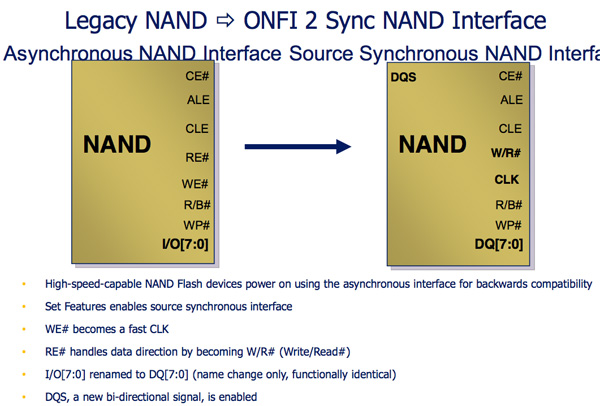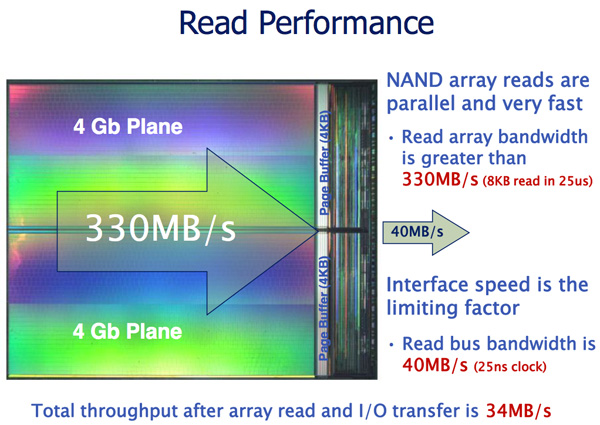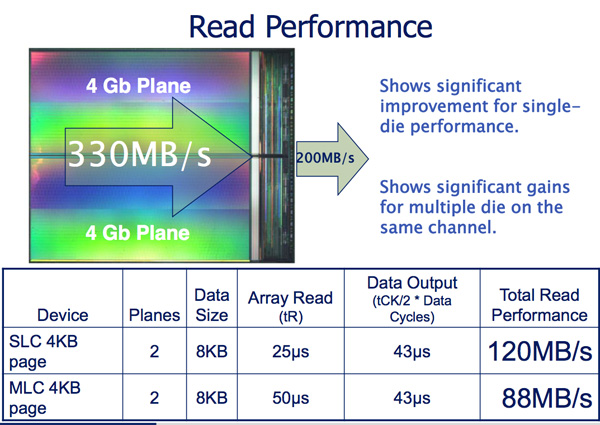SandForce Announces Next-Gen SSDs, SF-2000 Capable of 500MB/s and 60K IOPS
by Anand Lal Shimpi on October 7, 2010 9:30 AM ESTNAND Support: Everything
The SF-2000 controllers are NAND manufacturer agnostic. Both ONFI 2 and toggle interfaces are supported. Let’s talk about what this means.
Legacy NAND is written in a very straight forward manner. A write enable signal is sent to the NAND, once the WE signal is high data can latch to the NAND.
Both ONFI 2 and Toggle NAND add another bit to the NAND interface: the DQS signal. The Write Enable signal is still present but it’s now only used for latching commands and addresses, DQS is used for data transfers. Instead of only transferring data when the DQS signal is high, ONFI2 and Toggle NAND support transferring data on both the rising and falling edges of the DQS signal. This should sound a lot like DDR to you, because it is.

The benefit is tremendous. Whereas the current interface to NAND is limited to 40MB/s per device, ONFI 2 and Toggle increase that to 166MB/s per device.

Micron indicates that a dual plane NAND array can be read from at up to 330MB/s and written to at 33MB/s. By implementing an ONFI 2 and Toggle compliant interface, SandForce immediately gets a huge boost in potential performance. Now it’s just a matter of managing it all.
The controller accommodates the faster NAND interface by supporting more active NAND die concurrently. The SF-2000 controllers can activate twice as many die in parallel compared to the SF-1200/1500. This should result in some pretty hefty performance gains as you’ll soon see. The controller is physically faster and has more internal memory/larger buffers in order to enable the higher expected bandwidths.

Initial designs will be based on 34nm eMLC from Micron and 32nm eMLC from Toshiba. The controller does support 25nm NAND as well, so we’ll see a transition there when the yields are high enough. Note that SandForce, like Intel, will be using enterprise grade MLC instead of SLC for the server market. The demand pretty much requires it and luckily, with a good enough controller and NAND, eMLC looks like it may be able to handle a server workload.










84 Comments
View All Comments
Casper42 - Friday, October 8, 2010 - link
You know what else comes out in Early 2011?Sandy Bridge and the Intel 60 series chipsets.
Intel has already announced they will have 2 SATA 6Gbps ports on those chipsets.
Core i7 2620M with 8GB of DDR3 and a SATA6G SSD? Yes Please!
Stick a 750GB Green SATA Drive where the Optical drive usually goes and then just use a $40 USB DVD Drive when you really need it (rarely now that DVDs include the "digital copy" and software companies are embracing online delivery.
And of course throw in an nVidia Optimus 4xx as well.
Hector2 - Thursday, October 7, 2010 - link
So we have a battle of Specs ? Sure makes the Marketer's jobs easierjwilliams4200 - Thursday, October 7, 2010 - link
In a battle of specs, I am going to trust Intel a lot, and Sandforce not at all.The most careful SSD reviews these days are coming from bit-tech.net. They use AS-SSD to test sequential write speed for incompressible data, and also they fill the drive up with data, delete it, run TRIM, and then test the drive again.
http://www.bit-tech.net/hardware/storage/2010/09/0...
Check out the lighter-colored bars on the sequential write speeds. Those are the speeds after writing a lot to the drives and then TRIM. Note that the Intel X25-M 160GB gets 99 MB/s sequential write even after being heavily used. It is spec'ed at 100 MB/s sequential write. Just as Intel specified, so their SSD performs.
Next, look at the Sandforce drives lighter-bar sequential write, for example, the OCZ Vertex 2E 120GB. This is a drive that is spec'ed at 275 MB/s sequential write. But when someone actually measures the speed with realistic data, after the drive has been used, it only manages a pathetic 83 MB/s sequential write. That is only 30.2% of the spec'ed value, and is even lower than Intel's 99 MB/s !
Or look at the Revodrive, which is two SF drives in parallel with a RAID controller. It is spec'ed at 490 MB/s sequential write, which looks quite similar to what Sandforce is claiming for the SF2000 series. But what is the actual, real world sequential write for the Revodrive? bit-tech.net measured it, and it is a pathetic 139 MB/s. A single Crucial C300 256GB drive achieves 190 MB/s !
Bottom line is that none of Sandforce's specifications can be believed.
Chloiber - Thursday, October 7, 2010 - link
Just wanted to tell you, that the german site computerbase.de came to the same conclusion. They even had a talk with OCZ about it and they admitted it: the sandforce drives lose performance after being heavily used which cannot be restored with TRIM, only with a secure erase.Sequential write on random data dropped from 140MB/s (fresh) to 90MB/s (used) on a Vertex 2 120GB.
Real world usage was still pretty good though.
Zan Lynx - Friday, October 8, 2010 - link
Agreed about real world usage.You have to benchmark the drives with an application you're actually using. If you only write encrypted data that looks random, then do not buy a Sandforce.
On the other hand, if you use real programs the data will not be random and the Sandforce will perform well.
DoktorSleepless - Friday, October 8, 2010 - link
They use incompressable data for what you linked. That's not realistic. That's worst case scenario, which is unlikely to happen. I believe anand did a set of similar tests and got a low speed too. SF's speed relies heavily on compressing data.hackztor - Thursday, October 7, 2010 - link
they never mentioned price. All is cool for 1gb in 2 seconds, but if the price is 1000, I think many consumers will have a hard time justifying this.Phynaz - Thursday, October 7, 2010 - link
It's not a consumer device.Chloiber - Thursday, October 7, 2010 - link
"Enterprise", "Industrial" - everything but conusmer.slickr - Thursday, October 7, 2010 - link
I suspect that SandForce worker force is out of this world. I think the slides that we just witnessed today confirm that indeed Aliens have come to this planet and are working for SandDorce. How else would you explain such amazing performance on very new technology in so short time?I call all UFO hunters and Aliens investigators to go to SandForce HQ and investigate, ladies and gentlemen this way be the most historic day in the history of planet earth by uncovering aliens working for a human firm.